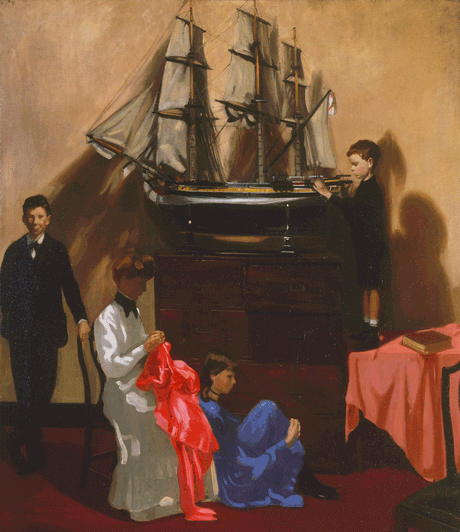
The enticing, eerie paintings of the Edinburgh-born artist Mabel Pryde Nicholson (1871-1918) have a strange magnetism, drawing one’s gaze into the world they create. Although she was clearly an artist, in Lucy Davies’s words, of “tensile strength”, her remarkable work has long been obscured.
In the latest addition to Eiderdown’s series of short books on modern women artists, Davies, the co-curator of the show Prydie: the life and art of Mabel Pryde Nicholson at The Grange Gallery, Rottingdean, brings Mabel into the public eye for the first time in the 21st century.
The Nicholson name is famous in the art world, made so by Mabel’s sons, the great British Modernist painter Ben Nicholson and the modernist architect Kit Nicholson, and her husband, William Nicholson (1872-1949), a portraitist and still-life painter. Mabel was an artist, too, training with Hubert von Herkomer at the Bushey School of Art (where she met her future husband), but her name had been almost entirely forgotten.
So much of the work done to rehabilitate the reputations and stories of women artists in the past few years has been encumbered by a wish to pull them “out of the shadows of men” or remove men from their stories altogether. Mabel’s life, as told so beautifully by Davies in this book, is a case study for the futility, and the foolishness, of trying to do so. Mabel was surrounded by men she loved, learned from and was influenced by throughout her life. There is no story without them, just as their stories are incomplete without her.
It is quite a feat to successfully write into the woolly, ambiguous space of what might have been or what has been lost. For artists such as Mabel, who pursued an artistic career from youth but never achieved sustained professional success, the sense of lost potential is key to understanding her and her work. “You have to wonder what she might have become,” writes Davies.
There is an anecdote that is particularly telling: Ben remembers his mother always going to “scrub the kitchen table” after a lot of “art talk”, which was “more extraordinary than it sounds today … the kitchen was a real Edwardian affair, with servants who had to be got out of the way”. This sense of alienation from the “art talk” and the world it entailed, and the obsessive escape into domestic chores, is a powerful symbol of Mabel’s frustration and sense of imposter syndrome as an artist. It was not just the labours of caring for home and children that kept her from the canvas, but a deeper sense of unworthiness.
The detective work Davies has undertaken with this project to piece together fragments of other people’s stories to bring Mabel to life is remarkable. Many of the sources she uses, such as her husband’s mistress’s biography of him, are fundamentally unreliable. The mistress, Marguerite Steen, describes Mabel and William’s marriage as having “left no happy memories behind”, erasing Mabel’s artistry and the joy she shared with her family. Another biographer, Lillian Browse, called her “a somewhat inconsequent wife”. But by excavating her life from those around her, Davies builds a narrative of a woman at the centre of the dynamic tides of British art at the end of the Victorian era and the dawn of the 20th century. She was clearly beloved by her children, who defended her against critics after her early death from the Spanish flu epidemic in 1918.
Mabel sat outside the traditional flow of -isms that characterise the history of modern art but was no less influenced by them. Among her and William’s glittering artistic social circle were Rudyard Kipling, Walter Sickert, Jacques-Emile Blanche, Edwin Lutyens, Max Beerbohm and William Orpen, who painted the family at home in Bloomsbury in 1907. But Mabel “chose to live obscurely”, according to her son-in-law Robert Graves: after the birth of her four children, she was consumed by her love for them and the work of raising them, turning away from her painting until they were older.
When she did return, she painted Rembrandtesque portraits and eerie interiors, often featuring members of her family. Some of her most exceptional works include mirrors which reflect the artist at work as well as the subjects of the painting, giving the space a multidimensional self-referentiality. She boldly confronts her identity as “artist” by putting herself in the picture, despite her struggle to accept that identity. The potent but slightly unresolvable sense of space in these works points to Mabel’s complex life, and the many different ways she defined herself as she evolved.
• Lucy Davies, Mabel Nicholson (Modern Women Artists series), Eiderdown Books, 64pp, 27 colour & b/w illustrations, £12.99 (hb), published 20 July
• Eliza Goodpasture is a PhD candidate at the University of York. Her research examines friendship between female artists in England in the late 19th and early 20th centuries


